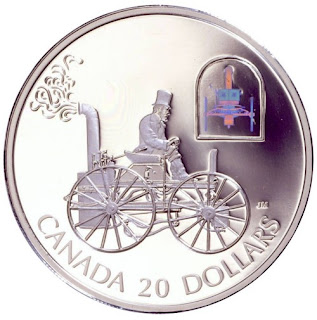Canada 20 Dollars Silver Coin 2000 H.S. Taylor Steam Buggy
Transportation Series
Obverse: Right-facing profile of Her Majesty Queen Elizabeth II by artist Dora de Pédery-Hunt, along with the year and face value.
Lettering: ELIZABETH II D • G • REGINA 2000.
Engraver: Dora de Pédery-Hunt.
Reverse: The coin showcases a H.S. Taylor Steam Buggy in action, with a hologram of the front of the buggy at the top right.
Inventor Henry Seth Taylor designed this steam buggy, an adaptation of a horse drawn carriage in 1867. It is now on display at the National Museum of Science and Technology.
Lettering: CANADA 20 DOLLARS.
Engraver: Bonnie Ross.
Mintage: 44367.
Composition: 92.5% silver, 7.5% copper.
Finish: proof.
Weight: 31.1 g.
Diameter: 38 mm.
Edge: serrated.
Face value: 20 Canadian Dollars.
Artist: Bonnie Ross, William Woodruff (reverse), Dora de Pédery-Hunt (obverse).
Manufacturer: Royal Canadian Mint.
Transportation Series
Transportation on Land, Sea and Rail Collection
The 2000 Transportation Series is the first set in a three year series. Each coin in the series has a $20 face value and features a hologram depicting each form of transportation. The series focuses on Canadian innovations in transportation on land, sea, and rail that contributed to our rich Canadian transportation history.
2000
2001
2002
Henry Seth Taylor steam buggy
The Henry Seth Taylor steam buggy is the first known car built in Canada. It was built by Henry Seth Taylor, a watchmaker and jeweller in Stanstead, Quebec in 1867. It was unveiled at the Stanstead Fall Fair that year. The vehicle was crashed into a creek shortly thereafter.
The Buggy was modeled after a US-built steam car Taylor had seen in 1864. It was designed by Taylor to have a coal-fired boiler for the carriage. Fully pressurized, the steam was used to move a piston attached to the rear axle, producing forward motion. The vehicle does not have a reverse gear or brakes. It was able to travel at a sustained 24kph (15 mph). The vehicle features thin strips of metal bent around the edge of the wheels in place of rubber tires. It is powered by a two-cylinder boiler mounted behind the driver. Steam is generated in the vertical coal-fired boiler, which is connected by rubber hoses to a six-gallon water tank located between the front wheels. The vehicle lacks a coal box, but has a storage nook for lump coal or wood under the driver’s perch.
The vehicle weighs 500 pounds. The boiler (as designed) can withstand 60 lbs of pressure. It was the only example built, not having been meant for mass production; rather, it was exhibited as a curiosity at fairs around the area.

